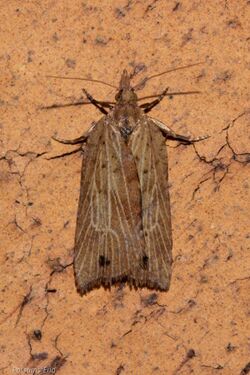Biology:Planotortrix notophaea
| Planotortrix notophaea | |
|---|---|

| |
| Male holotype specimen held at the Auckland War Memorial Museum. | |
| Scientific classification | |
| Domain: | Eukaryota |
| Kingdom: | Animalia |
| Phylum: | Arthropoda |
| Class: | Insecta |
| Order: | Lepidoptera |
| Family: | Tortricidae |
| Genus: | Planotortrix |
| Species: | P. notophaea
|
| Binomial name | |
| Planotortrix notophaea (Turner, 1926)[1]
| |
| Synonyms[2] | |
| |
Planotortrix notophaea, the blacklegged leafroller, is a species of moth in the family Tortricidae. It is endemic to New Zealand. It was also present near Sydney in Australia , but this population is thought to be extinct.
Taxonomy
This species was first described in 1926 by A. J. Turner and named Tortrix notophaea.[3] Turner used a specimen sent to him by Alfred Philpott that had been reared in New Zealand.[3] It had emerged from a cutting of Acacia decurrans that had been collecting at Epping, Sydney.[3] The holotype specimen used for this description is now held at the New Zealand Arthropod Collection.[2] No other specimens have been collected in Australia and as such that population is thought to be extinct.[4] It has been hypothesised that this specimen resulted from the species becoming established in Epping as a result of a commercial nursery near where it was collected.[5] In 1928 George Hudson illustrated this species under the name Tortrix excessana.[2] In 1946 J. T. Salmon, thinking he was describing a new subspecies, named this moth Ctenopseutis obliquana distincta.[6] The specimen Salmon used for this description was collected by Graham Turbutt on the 23 April 1946 at Great Island and is now held at the Auckland War Memorial Museum.[7] This name was synonymised by John S. Dugdale in 1966 and the species was placed by him within the genus Planotortrix.[5]
Description
The wingspan is 15–18 mm.[4] This species is a brown fuscous colour with antennae that are fuscous white.[3] The abdomen is grey with a lateral black stripe and fuscous coloured legs.[3] There is a diamond-shaped patch in the discal cell of the forewings.[4] This species can be variable in appearance.[4]
The larvae of this species have heads that are green with narrow brown stripes, a green body and white lateral stripes as well as black forelegs.[4]
Distribution
This species is endemic to New Zealand.[8][9] It is found on the Three Kings Islands, the South Island and the North Island.[4]
Habitat and host species
This species prefers coastal to montane forest habitat.[4] The larvae are polyphagous, but prefer small-leaved, hard-leaved gymnosperms and dicotyledonous angiosperms.[4] Endemic host species include Aristotelia serrata, Coprosma grandifolia, Metrosideros excelsa, and Prumnopitys taxifolia.[10] The larvae feed on leaves, buds and stems from a shelter made of foliage webbed together with silk.[11]
Human interactions
P. notophaea is regarded as being a damaging pest of commercial conifer forests.[11] It is listed as a Quarantine Pest when exporting forest goods from New Zealand to other countries.[12]
References
- ↑ Gilligan, T. M.; Baixeras, J.; Brown, J. W.; Tuck, K. R.. "Planotortrix species". tortricid.net. http://www.tortricidae.com/catalogueSpeciesList.asp?gcode=730&chkLastInput=.
- ↑ 2.0 2.1 2.2 Dugdale, John S. (1988-09-23). "Lepidoptera - annotated catalogue, and keys to family-group taxa" (in en). Fauna of New Zealand 14: 1–264. https://www.landcareresearch.co.nz/__data/assets/pdf_file/0003/49008/FNZ14Dugdale1988150.pdf. Retrieved 3 May 2019.
- ↑ 3.0 3.1 3.2 3.3 3.4 Turner, Alfred Jefferis (1926-01-01). "Studies in Australian Lepidoptera". Transactions of the Royal Society of South Australia 50: 120–155. https://biodiversitylibrary.org/page/41571878.
- ↑ 4.0 4.1 4.2 4.3 4.4 4.5 4.6 4.7 Dugdale, J. S. (1990-07-01). "Reassessment of Ctenopseustis Meyrick and Planotortrix Dugdale with descriptions of two new genera (Lepidoptera: Tortricidae)". New Zealand Journal of Zoology 17 (3): 437–465. doi:10.1080/03014223.1990.10422943. ISSN 0301-4223.
- ↑ 5.0 5.1 Dugdale, J. S. (1966). "A new genus for the New Zealand 'elusive tortrix' (Lepidoptera: Tortricidae: Tortricinae)". New Zealand Journal of Science 9 (2): 391–398. http://www.bugz.org.nz/WebForms/ResultDetails.aspx?CurrentDoc=28980B57-901B-439C-979A-09BA7B74B566&back=true&NewDoc=true&searchType=1&SearchString=Dugdale.
- ↑ Salmon, J. T. (20 December 1948). "New Species and Records of Lepidoptera from the Three Kings Islands, New Zealand". Records of the Auckland Institute and Museum 3 (4): 309–311.
- ↑ "Planotortrix notophaea". Auckland War Memorial Museum. 22 November 2002. http://www.aucklandmuseum.com/collections-research/collections/record/am_naturalsciences-object-141208.
- ↑ "Planotortrix notophaea (Turner, 1926)". Landcare Research New Zealand. http://www.nzor.org.nz/names/df8a0180-7ad0-450b-83ea-5e767eeb4104.
- ↑ , p. 465, Wikidata Q45922947
- ↑ "Planotortrix notophaea (Turner, 1926) Herbivore report". Manaaki Whenua Landcare Research. https://plant-synz.landcareresearch.co.nz/ReportForm.aspx?RecordId=1373&Type=H&ReportType=Adv&SortBy=Alpha&Biostatus=a,c,e,n.
- ↑ 11.0 11.1 Nuttall, M. J. (1983). "Greenheaded leafroller, Blacklegged leafroller and Light Brown Apple Moth". https://www.scionresearch.com/__data/assets/pdf_file/0009/3987/Ent58Planotortrixspp.pdf.
- ↑ "Forest Products Export Standards - Phytosanitary Requirements". 7 March 2017. https://www.mpi.govt.nz/law-and-policy/requirements/icpr-importing-countries-phytosanitary-requirements/forestry-icprs/israel/#quarantinepests.
Wikidata ☰ Q14113463 entry
 |



